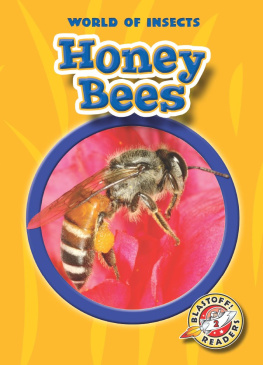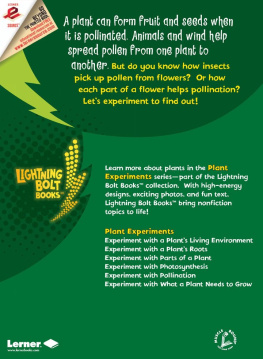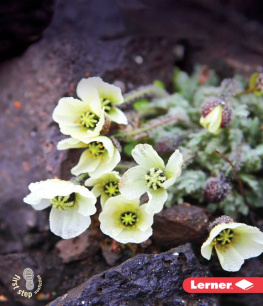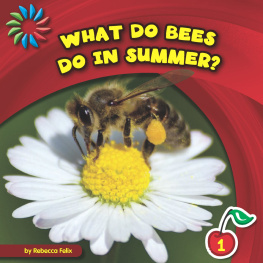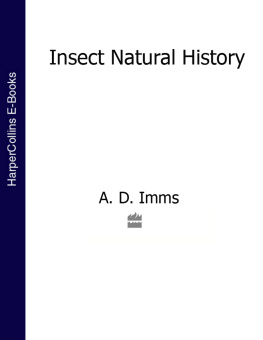
Sarah A. Corbet
S. M. Walters, Sc. D., V.M.H
Prof. Richard West, Sc. D., F.R.S., F.G.S
David Streeter, FIBiol
Derek A. Ratcliffe
The aim of this series is to interest the general reader in the wildlife of Britain by recapturing the enquiring spirit of the old naturalists. The editors believe that the natural pride of the British public in the native flora and fauna, to which must be added concern for their conservation, is best fostered by maintaining a high standard of accuracy-combined with clarity of exposition in presenting the results of modern scientific research.
For a generation of pollination ecologists, the forerunner of this book was an inspiration and something of a bible. Its authors are professional biologists, and at the same time excellent naturalists with a love of books and with expertise in photography. By drawing together the hitherto rather separate botanical and zoological European literature of pollination ecology, and enriching it with their own wide experience and their excellent photographs, they drew many people into pollination ecology. This is now a fast-growing research area with many devotees throughout the world, and there is a risk that the rapid development of particular aspects will make its practitioners lose sight of the main field, and particularly of the basis in natural history that attracted many of us to the topic in the first place. The time has come for a fresh synthesis, particularly now that a decline in native pollinating communities threatens the viability of crops and wild flowers, so that the understanding and management of pollination systems is becoming a practical necessity.
Michael Proctor and Peter Yeo have been joined by a third author, Andrew Lack, to help them produce this new synthesis. It is a fresh book, with new content and a different title, but it retains the qualities that made its forerunner such an important stimulus to the development of interest in the subject of pollination ecology. Its scope has been widened; the British focus of the earlier book has been broadened so that its scope is now worldwide, including, for example, pollination by birds and bats and some remarkable interactions involving exotic orchids.
Since its inception, the New Naturalist series has been known for its illustrations. It is appropriate that this, with its focus on flowers and animals of such beauty and intricacy, should be among the most lavishly illustrated volumes in the series so far. In the New Naturalist tradition, it will appeal to the eyes as well as the minds of naturalists. Perhaps it will help to inspire the new generation of pollination ecologists who will be responsible for protecting and maintaining this delicate mutualism in the decades to come.
Pollination has been a quintessential part of popular natural history for as long as any of us, or our parents or our grandparents, can remember, and the sight of insects busying from flower to flower holds a quite unabated fascination today. Awareness of the need for pollination of the date palm stretches back into classical antiquity, but general recognition of the significance of pollination, and the importance of flower-visiting insects, had to wait for the scientific reawakening which gathered pace from the closing decades of the seventeenth century onwards. As time went on, other agents of pollination wind, water, birds and bats were found to play a part. One of the main reasons for the enduring appeal of the flower-insect relationship must be that it is so fundamentally one in which both partners benefit. In our present go-getting age we can sometimes be more conscious of how the partners exploit one-anothers services (and indeed there are some examples of very one-sided exploitation between flowers and their visitors). But in some ways this only adds to its appeal, and to the intellectual challenge of elucidating how the flower-pollinator relation has come into being, and how it is maintained in the competitive world of natural selection.
The New Naturalists already include The Pollination of Flowers, as No. 54 in the series. That book was published in 1973, near the beginning of a resurgence of interest in pollination biology. A period of sixty years or so, from the publication of Knuths monumental compendium in the early years of our century until about 1965, can be seen with hindsight as a rather unproductive time for pollination research. Some notable contributions were indeed made, but the subject was something of a backwater from the mainstream of biological progress. Over the last thirty years all that has changed dramatically. Not only has pollination biology emerged as a dynamic research field, but it has taken on a wholly new complexion. The cause of this renaissance and the flood of new papers on pollination has been an explosion of interest in the ecology and evolution of pollination, and the implications of this for many general aspects of the ecology, evolution and genetics of populations. The Pollination of Flowers recorded the beginnings of this upsurge of new interest. Over the last three decades, pollination biology has contributed major insights into the way plant populations function and it has given us a much deeper understanding of how plants have evolved. It has also influenced our perceptions on the evolution of social insects, and has played a major part in developing current ecological and evolutionary theories. These wider implications have kept pollination studies at the forefront of ecology. This in turn has rekindled interest in the more classical observational and descriptive aspects of pollination and these too have advanced significantly, so we see today a buoyant and active subject advancing on many fronts.
When the idea of updating The Pollination of Flowers was suggested in the late 1980s it soon became obvious that we should have to rewrite the book completely. This is the result. Taking the earlier book as a starting point, the first and largest change was to invite a third author, Andrew Lack, to join the team specifically to cover the work on ecology and evolution that had been done since 1973. The three of us together were responsible for the shape and character of the present book, which differs from its predecessor in two main ways. First, we have shifted the emphasis towards a more functional view of the benefits and costs of the pollination relationship to flowers and their visitors, and the ways in which these interact. Second, while we have written the book from a primarily British Isles standpoint, we have taken a more liberal view of the New Naturalist brief to interest the general reader in the wildlife of Britain than we did in the earlier book. The preface to The Pollination of Flowers called pollination an obstinately international subject, and it has become ever more so as years have passed. Much of the research on pollination biology since 1970 has been done in North America, with a significant quantity from tropical countries around the world and from the southern hemisphere. The results, along with those of continuing study in Europe, are often relevant to all pollination relationships, and to understanding the pollination of our native plants here in Britain. Added to that, travel has become easier and we have surely all become more international in outlook in the last quarter century. The countries of continental Europe, the Mediterranean coast, and increasingly North America, Africa and places even farther afield, are coming within the experience of holidaying (and sometimes working) Britons part of our home range. Perhaps even more significant is the much wider awareness of the worlds flora and fauna generally brought about by the superb natural history films which have become so regular a feature of television since David Attenboroughs
Next page

